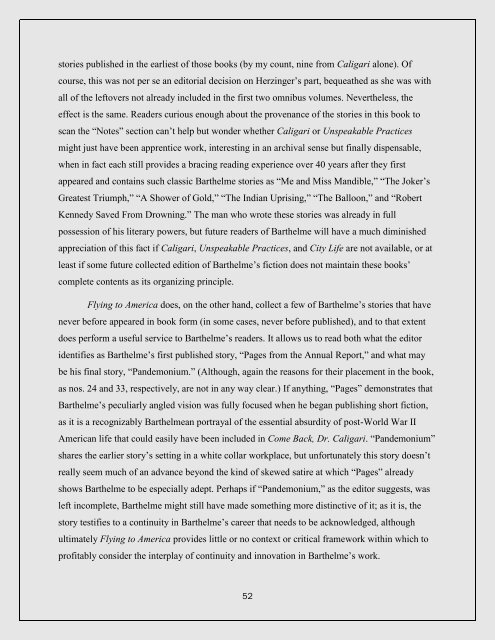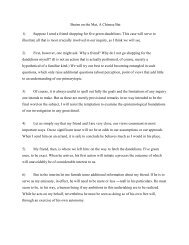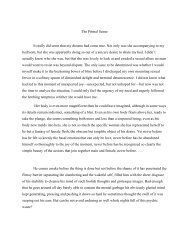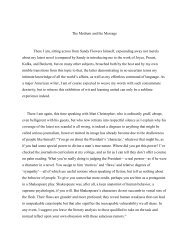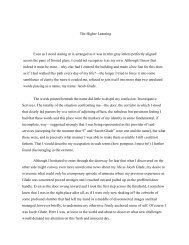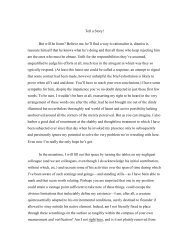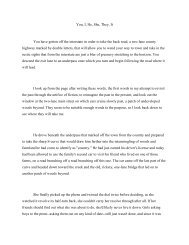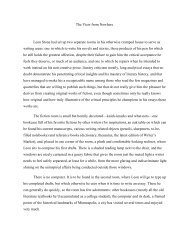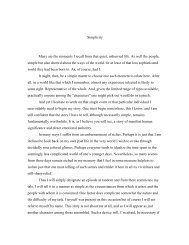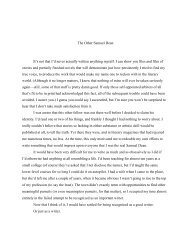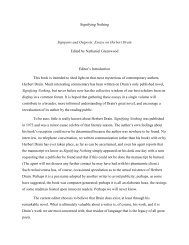APF
Create successful ePaper yourself
Turn your PDF publications into a flip-book with our unique Google optimized e-Paper software.
stories published in the earliest of those books (by my count, nine from Caligari alone). Of<br />
course, this was not per se an editorial decision on Herzinger’s part, bequeathed as she was with<br />
all of the leftovers not already included in the first two omnibus volumes. Nevertheless, the<br />
effect is the same. Readers curious enough about the provenance of the stories in this book to<br />
scan the “Notes” section can’t help but wonder whether Caligari or Unspeakable Practices<br />
might just have been apprentice work, interesting in an archival sense but finally dispensable,<br />
when in fact each still provides a bracing reading experience over 40 years after they first<br />
appeared and contains such classic Barthelme stories as “Me and Miss Mandible,” “The Joker’s<br />
Greatest Triumph,” “A Shower of Gold,” “The Indian Uprising,” “The Balloon,” and “Robert<br />
Kennedy Saved From Drowning.” The man who wrote these stories was already in full<br />
possession of his literary powers, but future readers of Barthelme will have a much diminished<br />
appreciation of this fact if Caligari, Unspeakable Practices, and City Life are not available, or at<br />
least if some future collected edition of Barthelme’s fiction does not maintain these books’<br />
complete contents as its organizing principle.<br />
Flying to America does, on the other hand, collect a few of Barthelme’s stories that have<br />
never before appeared in book form (in some cases, never before published), and to that extent<br />
does perform a useful service to Barthelme’s readers. It allows us to read both what the editor<br />
identifies as Barthelme’s first published story, “Pages from the Annual Report,” and what may<br />
be his final story, “Pandemonium.” (Although, again the reasons for their placement in the book,<br />
as nos. 24 and 33, respectively, are not in any way clear.) If anything, “Pages” demonstrates that<br />
Barthelme’s peculiarly angled vision was fully focused when he began publishing short fiction,<br />
as it is a recognizably Barthelmean portrayal of the essential absurdity of post-World War II<br />
American life that could easily have been included in Come Back, Dr. Caligari. “Pandemonium”<br />
shares the earlier story’s setting in a white collar workplace, but unfortunately this story doesn’t<br />
really seem much of an advance beyond the kind of skewed satire at which “Pages” already<br />
shows Barthelme to be especially adept. Perhaps if “Pandemonium,” as the editor suggests, was<br />
left incomplete, Barthelme might still have made something more distinctive of it; as it is, the<br />
story testifies to a continuity in Barthelme’s career that needs to be acknowledged, although<br />
ultimately Flying to America provides little or no context or critical framework within which to<br />
profitably consider the interplay of continuity and innovation in Barthelme’s work.<br />
52


